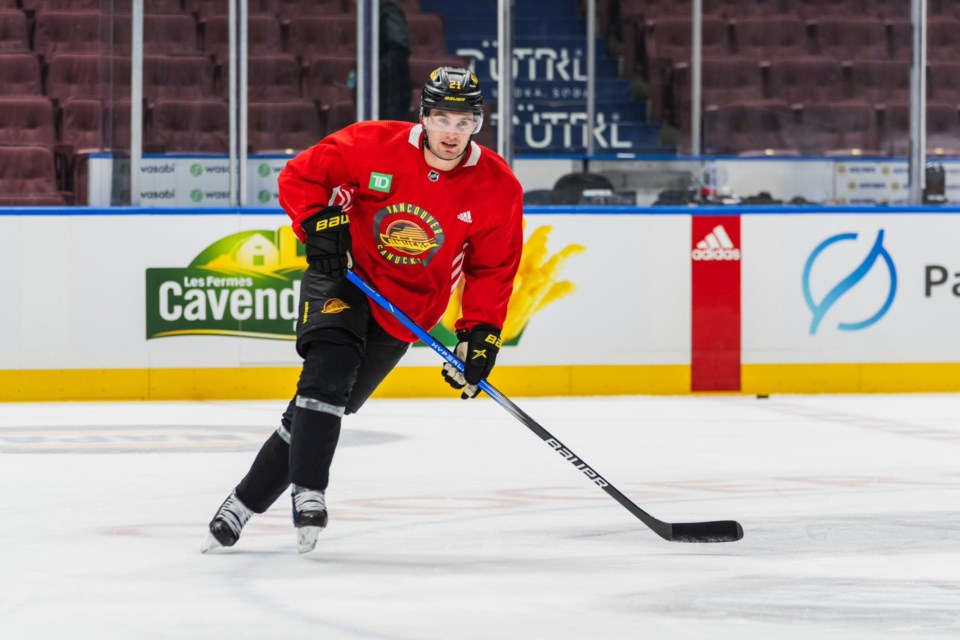Nils Höglander is the most efficient goalscorer in the NHL this season.
No one else has done so much with so little. Despite his 5-on-5 ice time averaging just 10:47 per game, Höglander still has 17 goals. His goalscoring rate of 1.82 5-on-5 goals per 60 minutes leads the entire NHL, ahead of a little-known player named Auston Matthews, who averages 1.69.
“He’s a home run hitter for us,” said head coach Rick Tocchet after Thursday’s morning skate. “He comes up with some big goals for us.”
It’s enough to make one wonder why the player who is fourth on the Canucks in goalscoring is just short of dead last on the team in average ice time, ahead of only fourth-line centre Nils Åman. Why isn’t Höglander getting more ice time?
"There's still some things he's got to work on."
Even as Höglander has been elevated up the lineup to play with Elias Pettersson and Elias Lindholm, an increase in ice time hasn’t come along with that elevation. On Tuesday against the Chicago Blackhawks, despite scoring a goal in his third straight game, Höglander had the second-lowest ice time in the game at just 10:41, barely ahead of fourth-liner Sam Lafferty.
In fact, Höglander’s ice time has still been so limited that even head coach Rick Tocchet was taken aback by how little the winger played against the Washington Capitals a couple of nights earlier.
“I thought Höggy was really good,” said Tocchet after that game. “I don’t know why he only got 11:12, I don’t know how, I thought I played him.”
The question of Höglander’s ice time has evidently been on Tocchet’s mind or at least in his ears, as he was ready for a defence of his usage after Thursday morning’s skate.
“I know it’s the big thing around here,” said Tocchet. “It’s like, if you play [Höglander] too much, does he develop? There’s still some things he’s got to work on. I think what we’ve done here is perfect for him.”
In other words, bringing Höglander along slowly and giving him limited ice time has been good for his development and helped the coaching staff hammer home some of the staples that they want him to work on.
"His defensive game is getting better."
The issue for Höglander isn’t the offence; it’s the defence.
“His defensive game is getting better,” said Tocchet. “It’s not there yet, but it’s getting better. It’s getting better. I think the coaching staff have done a nice job — the [Sedin] twins have worked with him a lot too.”
The numbers back that up. As much as Höglander has been an offensive dynamo in his limited minutes, he was a defensive liability earlier in the season.
Through the team’s first 32 games, Höglander had the fourth-highest rate of expected goals against among Canucks forwards — 3.09 xGA per 60 minutes at 5-on-5 — behind only the match-up line of Brock Boeser, J.T. Miller, and Phil Di Giuseppe, who had the excuse that they were hard-matched against the opponents’ top lines every night.
For Höglander to be on the ice for so many chances against in a sheltered role was a problem.
Since then, however, there has been a distinct turnaround. In the Canucks’ last 22 games, Höglander has the fourth-lowest rate of expected goals against among Canucks forwards, averaging 1.83 xGA per 60 minutes at 5-on-5. That’s behind only Conor Garland, Teddy Blueger, and Pius Suter, who have all been praised for their defensive games.
That is a major improvement for Höglander, though it still needs to be tested against tougher competition. There are also still defensive bumps in the road, such as when he failed to box out his check on the Detroit Red Wings’ tying goal that sent Saturday's game to overtime.
"He's a buzzsaw taking it to the net."
Tocchet also suggested that Höglander’s style of play might require more limited minutes to avoid burnout.
“I think when you extend his minutes to 14, he gets really tired with the way he plays,” said Tocchet. “Listen, he deserves probably a couple more minutes, don’t get me wrong, and we probably put him on the power play tonight, maybe give him a shot, but like the way we’re developing him.”
Getting some power play time will certainly help get Höglander’s minutes up without too much more wear and tear. It’s been odd to see other players like Sam Lafferty and Ilya Mikheyev get time on the second power play unit without results when a player with Höglander’s skill level was left on the bench.
Tocchet sees Höglander primarily as a net-front presence on the power play.
“I think you've got to keep him around the net,” said Tocchet. “I'm not sure he's a half-wall guy, just handling pucks like that. I think he's a quick-strike guy. You know, get him the puck and if there's an open area, he's a buzzsaw taking it to the net. I think that's the best way to use him.”
“Or any loose pucks, he's gonna chase down,” he added. “I think that's where he'll be at his best, for sure.”
At morning skate, Höglander practiced with the second power play unit, even if it seems he's only getting the opportunity because of Dakota Joshua's injury. He got some tips for net-front play from one of the Canucks’ top power play minds, J.T. Miller.
With a little bit more ice time, maybe Höglander can hit a few more home runs for the Canucks.



